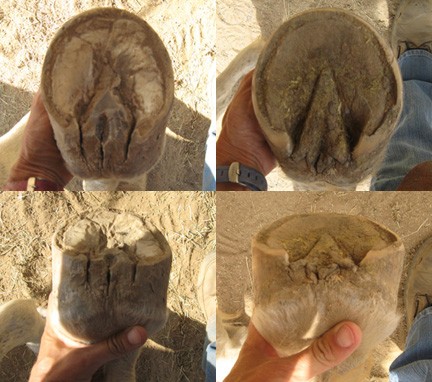A must read excellent article found in The Thoughtful Horseman for any one that’s new to Natural Hoof Care and Protective Horse Boots, such as Easyboot Gloves and Bares by EasyCare.
In six months to a year, your horse will have essentially grown new feet. Some horses are completely comfortable much sooner than that (3 to 4 months is common). You will be astounded at the difference, and thrilled with the soundness and durability of your barefoot horse. But until that time, your horse may need boots and pads to be comfortable in his newly de-shod feet, particularly when he is asked to carry a rider’s weight or work on rugged or rocky terrain.
It is important to understand why the horse’s feet may be tender during the transition. It is NOT the barefoot trim….I work very carefully to not remove material that the horse needs, unlike a typical “pasture trim”. My goal is to keep the horse as comfortable as possible through the transition. Most horses, even horses with no serious hoof pathologies, experience tenderness on their newly bare feet for the one or more of the following reasons:
Left: at set up trim, September 2008
Right: the same hoof, April 2009
1. Inadequate calloused sole.
Farrier’s routinely carve sole from the bottom of the horse’s foot. They do this for a number of “reasons”: to create a flat plane upon which to set the shoe, to make the foot look more esthetically “neat”, and to raise the sole of the foot off of the ground to “prevent soreness”. It takes months for the horse to grow and callous sole, and our goal is to develop at least a half inch of good, tough sole across the bottom of the foot. It is not uncommon to see horses with less than an eighth of an inch of sole protecting the inner structures of the foot when they are first deshod. Even if the sole does have adequate thickness, it will need to callous. Inadequate calloused sole is the number one reason horses are tender footed after shoes are removed.
2. Lack of fully developed digital cushion and lateral cartilages
If the back of the foot has never been allowed to develop through pressure and release on the sole and frog, the horse never develops the digital cushion and lateral cartilages. The digital cushion is literally a cushion between the frog and heel bulbs, and inner structures of the hoof. A healthy, well developed digital cushion is made up of tough, fibrocartilagineous tissue; in an immature or underdeveloped hoof, this cushion is soft and spongy. The lateral cartilages are the “scaffolding” that supports the back of the foot (like the coffin bone supports the front of the foot). Both the digital cushion and lateral cartilages can be stimulated and developed, and this is our goal. But until these structures are healthy, the horse may experience sensitivity in the back of the foot. See Bowker’s research paper on “good-footed” and “bad-footed” horses for more information. This sensitivity is mitigated by using boots and pads. Development is achieved through constant pressure and release on the sole and frog.
3. Undeveloped or carved and uncalloused frogs
Again, farrier’s almost ALWAYS pare the frog much more aggressively than is truly necessary. By doing so, they are removing the tough outer layer, and exposing tender, immature tissue underneath. It may look tidy, but the truth is, the horse needs that tough outer layer. With the exception of exfoliating frog material that is already loose, or paring excess growth, the frog should be allowed to toughen and callous. Until your horse toughens up and grows a wide, healthy frog, his frogs may be tender.
4. Frog infection
Those trimmed frogs are sitting ducks for opportunistic fungal and bacterial infections. A deep crease at the central sulcus is indicative of chronic infection. Chronic infection of the frog HURTS. Treatment as your hoof care provider prescribes will quickly help promote a thick, healthy frog.
5. Dramatically increased blood flow in the hoof
Nailing a shoe to a horse’s hoof IMMEDIATELY reduces perfusion (blood flow) by 50%. FIFTY PERCENT!! HALF!! Think about that…how does your arm or foot feel when you sleep on it funny and limit circulation? NUMB! How does it feel when the circulation is restored? REALLY UNCOMFORTABLE!!
You’ve made a wise, educated decision to transition your horse to barefoot…stick with it! Give it at least six months. Better yet, give it a year. You can always slap a shoe back on after that, and at least the hoof will have had a year to recuperate. ALL farrier’s texts recommend leaving the horse barefoot periodically to let the hoof recover. But believe it, if you stick with it that long, you will never, ever let a shoe come near your horse’s feet again.
Marcie Mendoza





